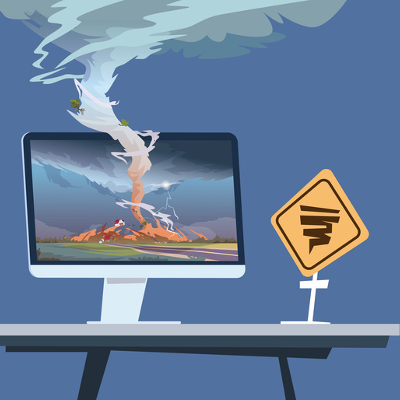Disasters Come in All Sizes

Each organization has a different definition for how they define a disaster. One business might feel that they can get away with losing a few files here and there, while another might need every file to be secure and protected against data loss. Regardless, the importance of being able to define the severity of a disaster cannot be underestimated, as you will need to properly gauge just how much hot water your business has landed in before it can pull itself up by the bootstraps and push forward.
Two factors are typically used to define just how bad a disaster is. The first is how much it costs to resolve the issue. This can include all sorts of costs associated with data loss, including hardware replacement costs and infrastructure damages. The second factor is the overall loss of productivity. This second factor ties into how much downtime your business experiences due to a data loss incident.
Determining the total cost of a disaster incident is critical, and it’s the only way that you can know for sure just how much work you’ll have on your hands just to get back into a bearable position. Depending on the type of disaster experienced, you could have a considerable amount of damage that needs to be repaired. For example, a hardware failure is perhaps the least costly incident. Of course, a hardware failure shouldn’t be underestimated, because it still means that you have to replace a server unit or workstation, as well as pay the employee working with that technology (or your whole organization, for that matter) for the time wasted while waiting to get back in business.
Other disasters can have far-reaching repercussions that drastically affect your organization’s ability to recover. A flood or similar natural disaster could destroy both your data infrastructure and physical infrastructure, including your office space. How much would it cost you to relocate an entire workforce? What about repairs to the building and/or renting a new one? All of these expenses hitting you at once is enough to crush even the most conservative budget–at least, if you’re unprepared for them, anyway.
If data security enters into the picture, you can bet that the costs of resolving the incident can increase exponentially. Depending on the type of information stolen, you could either have stolen credit card numbers, identities, and even health records. In the fallout of a data breach, you might be subject to fines due to regulations like HIPAA that could add insult to injury. Furthermore, you have your reputation to worry about. Will anyone be willing to work with your organization again if you’re negligent with important information? That’s a question that you never want to ask.
Downtime is another major factor for determining how bad a disaster is. Downtime can be defined as anytime your business doesn’t operate as intended. It can be something as simple as an employee not being able to access a critical account, or it could be something as sudden and impossible to avoid as one of the aforementioned disaster scenarios. What it boils down to is that your business loses money when it’s not being productive, so you should do everything in your power to keep this from happening.
Catalyst Technology Group can equip your business with an enterprise-level data backup and disaster recovery solution, as well as a business continuity plan that can help your business survive even the most disastrous scenarios. To learn more, reach out to us at (317) 705-0333.
What Recent Natural Disasters Remind Us About Our Business

With several large storms, wildfires, earthquakes, and floods trampling major cities all over the world, the concept of data backup and disaster recovery is a particularly relevant topic. Business owners must confront whether or not they are prepared to handle such events, because if they don’t, they’ll be risking the future of their business.
According to the Federal Emergency Management Agency (FEMA), 40 percent of small businesses never truly recover from a disaster. This jarring statistic, along with every single article about data loss and disaster recovery, should be enough to convince business owners to prepare for the worst. Yet, they don’t, and it’s often too late.
To ensure that your organization doesn’t forget the most important rules of business continuity, consider the following statements:
- Your data will always be at risk, regardless of where it’s stored. No location is completely safe from a natural disaster.
- Your physical infrastructure will be affected, but so will many other organizations’.
Business continuity planning is one of the most important things that businesses fail to implement before it’s too late to do anything about it. In a recent article published in The Hartford, five businesses struggle to stay afloat following a natural disaster. They describe all of the nightmarish events that happen after the disaster, and the difficulties of recovering from such a devastating incident. Each business faced different challenges, though. One company had to repurchase machinery and inventory that was damaged during the disaster, while another simply found that most businesses they had been working with prior to the disaster were no longer in operation, thereby threatening their business with lack of sales.
If you learn any lesson from these stories, it’s that proactive thinking and planning for the future can make all the difference between your business’ survival, and its failure.
Here are seven of the most important parts of business continuity planning, and why you’ll want to focus on them.
Important Documents and Records
You need to preserve any paper documents that are critical for your business’ success. You should try to keep multiple copies of your documents for storage in both your on-site office and off-site, just in case your office isn’t left standing or is unreachable. You should consider the 3-2-1 rule as well, which we’ll go into more detail later.
Here are a few examples of important business documents:
- Deeds
- Leases
- Insurance Papers
- Certificates/Licenses
- Banking Records
- Hard Copy of Business Continuity Plan
Contacts and Communications
The most critical asset a business has is their workforce. Social media has implemented features that let users tell their friends and family that they are safe and sound, and that’s for one reason: it’s terrifying to lose contact with someone you care about during a disaster. You should establish and maintain contact lists to ensure you know who has managed to escape the wrath of the disaster. You also need to retain communication lines, including via a phone call, text message, or email. You can have a web page set up so that your employees can update you with their whereabouts in the event of a disaster, which can be helpful if they’re unable to send a voicemail or make a call. You should be especially certain that your critical staff know how important they are to operations so that you can establish modes of communication with them.
Alternative Locations and Mobility
Virtualization and mobility are the keys to ensuring that your business can survive a disaster–particularly if you want to set up a secondary location in the event your primary site is unavailable for work. Virtualization services and the cloud allow employees to work remotely as well, so even if you have no office, there might be a possibility to continue operations. In situations like this, be sure to explicitly state when you expect to resume normal operations.
Vendor and Critical Client Lists
You want to make sure that you know who your important vendors and clients are following a disaster, as they will certainly be instrumental in your recovery. You want to ensure that you can inform them of your situation so that there is no miscommunication with whether or not you can fulfill your agreements. If you are able to resume operations, you’ll want them on your side so that business as usual can resume.
Data Backup and Hardware Replacement
Your data is one of the most critical parts of your business, and without a way to recover it, you’re just another business starting over following a disaster. You must make sure that your data is backed up regularly and stored in multiple locations. Furthermore, you must test the backups to make sure they are working as intended.
Planning for Emergencies
This section mostly contains what you want to do in the event of an emergency while you’re in the office. You should set aside provisions such as flashlights, batteries, water, and more, just in case something happens and you can’t escape the office. These supplies should be stocked and checked regularly. Furthermore, you want to plan out emergency exits, meeting points, and an inventory of important items. This is all just in case you need to file an insurance claim.
Review, Update, and Test Important Components
The importance of reviewing your data backups cannot be overstated, but that’s not all you should be testing. You need to check phone numbers, a roster of key individuals, and your alternative site of operations so that you can continue operating in case of the worst.
Is your business prepared to handle the worst data loss incidents and natural disasters? To find out, reach out to us at (317) 705-0333.

